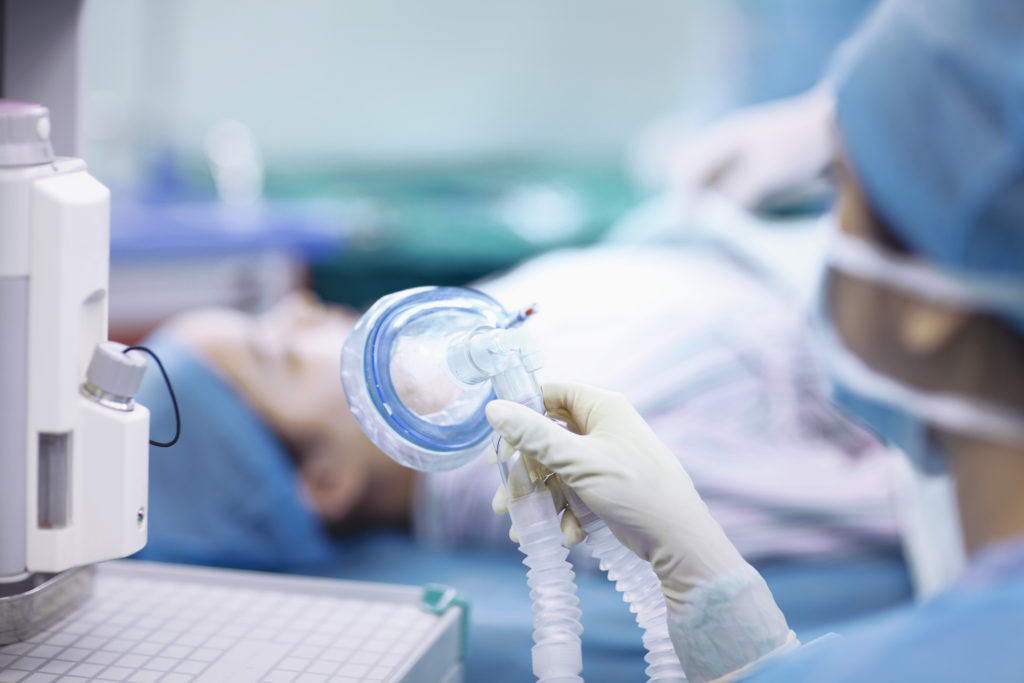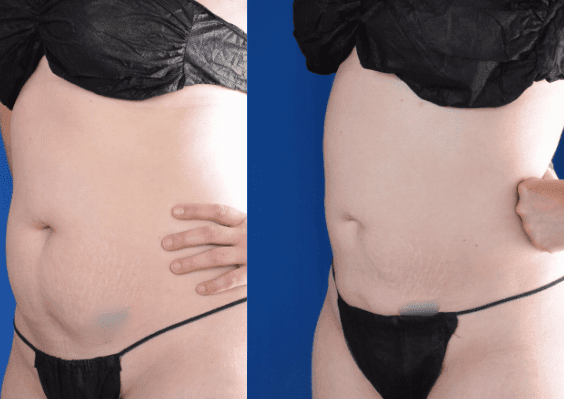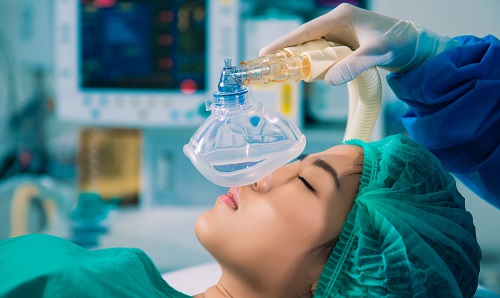Anesthesia is administered to a patient before a surgical procedure to prevent the patient from experiencing any pain and anxiety, keeping the patient in a state that allows the surgeon to perform the procedure safely. Awake anesthesia keeps the patient conscious, but comfortable and relaxed. General anesthesia renders the patient completely unconscious. Although a patient who’s been given general anesthesia may appear to be asleep, general anesthesia doesn’t actually induce sleep. It uses a combination of chemicals to induce a kind of coma that keeps the brain from responding to pain signals. It also comes with several risk factors.
Awake anesthesia, or “conscious sedation” is quickly replacing general anesthesia in hospitals and clinics. Surgeons and patients prefer it because of its improved safety, ease of use, better price, and quicker recovery time. (1)
At the Advanced Body Sculpting Institute, we use the latest technology, and awake anesthesia to give our patients the best possible experience. Dr. Zuhlke and our surgical team use carefully monitored medication that works locally to numb the area being treated and relax the patient. You can rest assured (and stay conscious!) that your liposuction procedure will be safe and any discomfort efficiently managed with awake anesthesia. To learn more about how awake anesthesia will benefit your body sculpting procedure, schedule a personal consultation today. Call our Englewood Colorado office at (303) 708-8770, and get started on sculpting the new you!
Anesthesia in General
The introduction of general anesthesia to the medical field was a revolutionary change in the way that surgeons practiced. Life-saving surgeries could now be performed with the patient resting comfortably. Before the mid-1800’s, patients had no choice but to remain conscious and suffer through excruciating procedures. In 1846, the physician and poet Oliver Wendell Holmes coined the term “anesthesia” after he witnessed a patient being administered ether before surgery. (2)
Nearly 200 years later, we’ve come a long way out of the ether! Anesthesia is a precise science. General anesthesia is still a valuable tool, and necessary for long and intensive surgeries. But as technology and surgical techniques have improved, certain procedures have become quicker and less invasive and no longer require that the patient be rendered unconscious.
Awake Anesthesia

General anesthesia renders your brain unable to respond to any stimulus, including processing pain signals. Local anesthesia numbs the targeted area without impacting the brain and causing unconsciousness. When a local anesthetic like lidocaine is applied to an area, it keeps the nerve from releasing the chemicals it needs to send the pain message to the brain. (3) As a result, you don’t feel a thing, but are still aware, and can still feel sensations in other areas of the body. (4)
Awake Anesthesia uses a combination of local anesthetics at the site of the procedure and a mild sedative to relax the patient. This state is also called “twilight sedation” as patients are in a relaxed in-between state. The American Society of Anesthesiologists explains that conscious sedation is a drug-induced “depression of consciousness” but patients are still able to respond to verbal commands or light touch. (5)
At ABS Institute, our patients enjoy PRO-NOX as a soothing sedative during their procedures. PRO-NOX is 50% nitrous oxide, or “laughing gas,” and 50% oxygen sedative gas. This system safely maintains patient comfort during procedures and has been used by dentists and plastic surgeons for decades. PRO-NOX can eliminate pain and anxiety during procedures that are performed with local or “awake” anesthesia. Patients who receive PRO-NOX enjoy a calming, enjoyable sensation so that they can receive their treatments comfortably. The effects of the gases subside within minutes after the procedure is complete, and has no adverse side effects.
Benefits of Awake Anesthesia
General anesthesia is necessary for some surgeries but it carries some well-known risks. Awake anesthesia eliminates the risks, effectively protects patients from pain and anxiety, and allows them to make a faster recovery without lingering side effects.
Unlike awake anesthesia, general anesthesia:
- Can damage neurons that are needed to form memories
- Requires a breathing tube
- Can lower blood pressure and heart rate to dangerous levels
- Requires a trained anesthesiologist
- Must be performed in a hospital setting
- Side effects of nausea and vomiting
- Extended recovery period
- Takes several days for the body to eliminate the medication
- Causes constipation that can last many days after the procedure
General anesthesia was found to be the cause of 75% of complications that required a transfer to the hospital. (3) It poses the risk for postoperative nausea and vomiting (PONV). This can be dangerous and even fatal if the patient isn’t fully conscious because of the risk of choking.
Another serious risk of general anesthesia is the development of deep vein thrombosis, which can lead to fatal pulmonary embolisms. (1)
Personal Consultation in Englewood
At ABS Institute, we make sure that our patients are fully informed about all aspects of their liposuction procedure, including their anesthesia. Your personal consultation is the first step towards getting the body of your dreams; don’t wait to schedule an appointment.
During your personal consultation, one of the friendly staff members at ABS Institute will evaluate your medical history. Together, you’ll discuss your expectations for your liposuction procedure and awake anesthesia, and all of your questions will be answered. You may need blood or urine tests and a physical exam to ensure that you can undergo the procedure safely. You’ll also be given personalized instructions in order to prepare for your liposuction procedure with Awake anesthesia.
Please share honestly to ensure your safety:
- Any allergies or health conditions
- How much alcohol you typically consume, and whether you do so daily
- Medicines, drugs, or supplements that you are taking
- Your previous experiences with anesthesia or sedation
- If you are or could be pregnant at the time of your procedure
Procedure
Getting comfortable with Awake anesthesia is the first step of your procedure. You’ll receive pain medications and injections of a local anesthetic like lidocaine in the area where your liposuction will be performed. You’ll also be given the PRO-NOX mask so that you’ll be able to administer the calming gasses as needed throughout your procedure.
Recovery From Awake Anesthesia
When your procedure is over, you’ll be transferred to a recovery room. Unlike general anesthesia, the body is able to process the chemicals in awake anesthesia quickly. PRO-NOX doesn’t bind to any of the cells in your bloodstream, so it leaves your system once you begin breathing normal air. You’ll quickly feel lucid and alert, and able to return home to begin recovering from your procedure. The potent medication used in your local anesthetic injections will continue to keep the area numb in the hours following your liposuction.
Cost
Our staff will be able to give you an accurate estimate for the cost of your procedure, including anesthesia, during your personal consultation. Costs will vary depending on the extent of your liposuction. We pride ourselves on providing affordable procedures that change lives, so your liposuction and awake anesthesia may be less than you think!
If you’re interested in learning more about awake anesthesia for your upcoming procedure, contact us today. To read more about the services we offer, follow our blog!
FAQ
What’s the difference between general anesthesia and awake anesthesia?
Awake anesthesia, or conscious sedation, leaves the patient relaxed but conscious. Patients receive a local anesthesia in the treatment area to eliminate pain during the procedure, and PRO-NOX gasses to alleviate any anxiety. General anesthesia renders the patient completely unconscious. Unlike awake anesthesia, which allows patients to quickly return to alertness, general anesthesia leaves patients disoriented and groggy for hours after their procedure.
What is local anesthesia?
Local anesthesia is a medication that is applied directly to the area to be treated. It’s usually injected and works by disabling the nerves, rendering them unable to communicate pain signals to the brain.
What are some of the risks of general anesthesia?
General anesthesia presents the possibility of postoperative nausea and vomiting, which can be dangerous, and pulmonary embolism, which can be fatal. It also requires a longer recovery time, and the medication used in general anesthesia can have side effects that last well after your surgery.
References
- Gart MS, Ko JH, Heyer KS, Mustoe TA. Breast Implant Procedures under Conscious Sedation. Plastic and Reconstructive Surgery. 2013;131(5):1169-1178. doi:10.1097/PRS.0b013e31828e2196
- Perkins B. How does anesthesia work? Scientific American. Published 2018. Accessed March 15, 2021. https://www.scientificamerican.com/article/how-does-anesthesia-work/
- Bagshaw KR, Hanenbaum CL, Carbone EJ, et al. Pain management via local anesthetics and responsive hydrogels. Ther Deliv. 2015;6(2):165-176. doi:10.4155/tde.14.95
- Marcus J, Tyrone J, Few J, Fine N, Mustoe T. Optimization of Conscious Sedation in Plastic Surgery Article Tools. Maxillofacial Surgeons. 1999;104(5):1338-1345. https://www.drthomasmustoe.com/content/uploads/2020/03/Optimization-of-Conscious-Sedation-in-Plastic-Surgery.pdf
- Pollock H, Forman S, Pollock T, Raccasi M. Conscious Sedation/Local Anesthesia in the Office-Based Surgical and Procedural Facility. Clinics in Plastic Surgery. 2013;40(3):383-388. doi:10.1016/j.cps.2013.04.014





